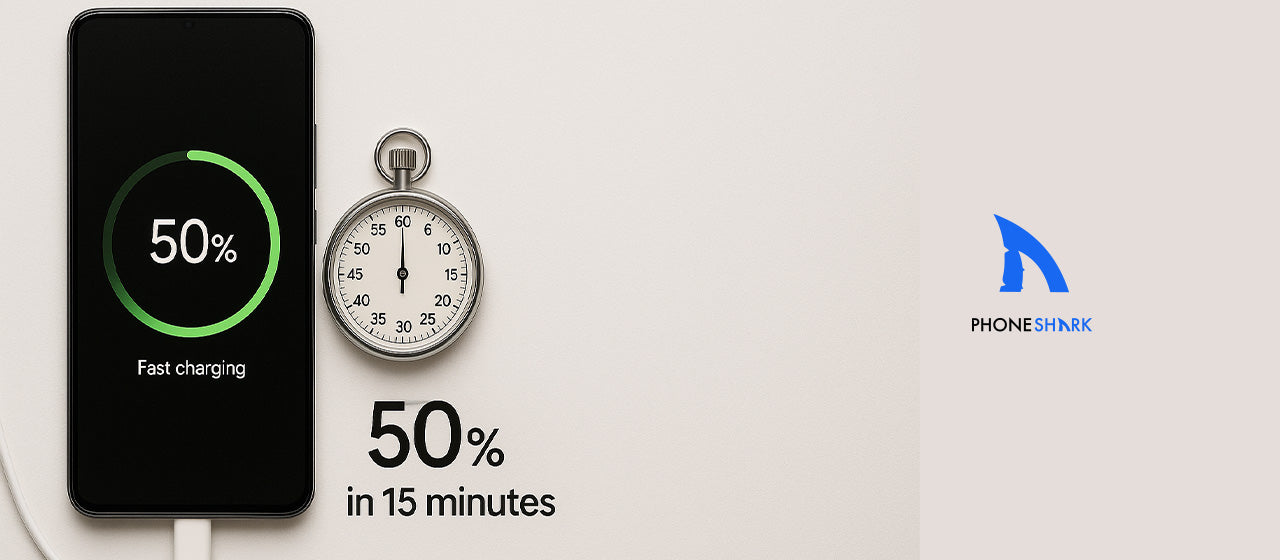The smartphone market in 2025 is bigger, more competitive, and more complex than ever. From foldables to AI-enhanced features to powerhouse cameras to the performance gap between flagship devices closing in on laptops – there is a dizzying array of choice for customers.
If you’re in the market for a new phone in 2025, it’s more important than ever to take a step back from the hype and sales pitches to first understand what matters most to you.
This definitive buying guide has everything you need to know to make the smartest possible smartphone purchase in 2025 and 2026 – from features and pricing to performance and brand comparisons.

1. Core Priorities: What Do You Really Need?
Before you get lost in a tangle of technical specs and brand claims, start by asking yourself this:
What do I use my phone for most? Gaming? Photography? Business productivity? Video streaming? Travel?
Answering this honestly will shape your choice more than anything a salesman says.
Common Use Cases:
-
Everyday Use: Browsing, texting, and social media
-
Photography: High-end camera systems and editing tools
-
Gaming: High refresh rates, thermal management, premium GPUs
-
Business: Long battery life, multitasking, security
- Creative work: Stylus support, large screens, AI-based editing tools
Don’t lie to yourself about what you really use a phone for. We all know that “all-day battery” ad is meaningless. The goal is to filter out the features you don’t need and focus on getting the best value for your use case.

2. Operating Systems: Android vs iOS in 2025
This may surprise you, but the Android versus iOS wars are as strong as ever. iOS 19 and Android 15 have more features in common than ever and the differences on paper are smaller.
But trust us, the user experience is still very distinct.
iOS 19 (Apple)
- Hassle-free integration with the rest of the Apple ecosystem
- Longest support in the industry (up to 6 years)
- Privacy/security controls and safeguards
- Face ID gets major upgrades (peripheral awareness, eye-tracking, adaptive UIs)
Android 15
- Maximum flexibility/customization
- Broader range of devices and price points
- Gemini-based AI features and more local on-device processing
- Split-screen multitasking, floating app windows polished
Verdict: If you prioritize stability, ecosystem integration, and long support, iOS is a no-brainer. If you want variety, optionality, and more customization, pick Android.
If you are heavily invested in either ecosystem (apps, wearables, Apple/Google Cloud, etc. ), switching OS may not be worth it for most users.

3. Display Tech: Bright, Smooth, and Foldable
Display quality across 2025 flagships is a staggering all-around jump from 2024.
Big upgrades:
- OLED vs AMOLED: AMOLEDs still lead in contrast and color vibrancy
- LTPO adaptive refresh rates: 1Hz-144Hz variable refresh is now found on most flagships
- Foldables: No longer gimmicky. Galaxy Z Fold 6 and OnePlus V Fold slim down, improve durability, move past novelty stage
- MicroLED displays making their first premium inroads
Recommended: 120Hz AMOLED for most users. Foldable for multitaskers/tablet work. Get anti-reflective coating if you use your phone outside a lot.

4. Performance: Laptop-level Chips
Smartphone vs PC distinction blurs further in 2025. So much power is now in the palm of your hand:
Top chipsets of 2025:
Apple A19 Pro: Absolute speed and efficiency monster. Great for creative use cases.
Qualcomm Snapdragon 8 Gen 4: Top-tier gaming, AI tasks, thermal management
Google Tensor G4: Optimized for Pixel features and AI workloads
Benchmarks don’t matter as much as real-world testing today. Every flagship chipset will handle day-to-day activities with ease, but power users should pay attention to thermal throttling and sustained performance.
Don’t forget to check for supporting hardware:
- LPDDR5X RAM (8GB or more for smooth multitasking)
- UFS 4.0 storage (faster app launch, game installs, file transfers)
- Vapor chamber cooling (thermal management for heavy gaming, streaming)

5. Camera Systems: Computational Photography Rules
Megapixels are no longer the defining factor in smartphone cameras. In 2025, top phones will have large sensors paired with AI-driven image processing to output DSLR-quality images.
Camera features to consider:
- Optical zoom (5x or more)
- Sensor-shift image stabilization
- AI night photography
- Real-time video enhancements (Cinematic Mode, Live HDR)
- 8K video at 60fps, ProRes video recording support
- Object erasers and background blur adjustments for video calls

Top camera phones of 2025:
iPhone 16 Pro Max: Great for video creators who want cinematic video and accurate colors
Google Pixel 9 Pro: Best overall AI processing/low-light performance
Samsung Galaxy S25 Ultra: Longest optical zoom, most versatile multi-lens setup 6. Battery Life & Charging Speeds
Fast charging has reached parity across 2025 flagships with most devices at 50% in less than 15 minutes.
Key battery specs:
- Battery size: 4500-5500mAh range is standard
- Charging speeds: 65W to 150W wired; 30W and above for wireless
- Battery health management tech (AI-based throttling/safeguards)
- Reverse wireless charging for powering up accessories or other phones
Daily battery endurance relies on more than just mAh. Software efficiency and background task management play larger roles than ever in how long your phone lasts.

7. AI Features: 2025’s Biggest Game-Changer
AI is no longer a buzzword. It is hard-coded into every aspect of smartphones in 2025 from voice assistance to camera post-processing to even typing faster than you can.
AI use cases in 2025:
- Live translation/transcription
- Smart photo retouching
- Real-time voice to text and vice versa
- AI generated content (texts, captions, video summaries)
- Call/Meeting summaries, smart replies, predictive scheduling
Gemini Nano is built into Samsung Galaxy S25 and other top Android flagships. Apple takes a privacy-first approach and uses Apple Intelligence. But all models still use a mix of local processing and cloud-based AI. We expect AI to play larger roles in battery management, UI personalization, and preemptive task handling.

8. Price Ranges and Value Picks (in AED)
Smartphone prices in 2025 remain high, but the good news is the sweet spot in each price bracket has gotten wider.
Flagships (AED 3,700+)
- iPhone 16 Pro Max – ~AED 5,100
- Samsung Galaxy S25 Ultra – ~AED 4,800
- OnePlus 13 Pro – ~AED 3,900
Features: Cameras, performance, longevity, build quality and price are all best-in-class in this bracket.
Mid-Range (AED 1,800–3,300)
- Google Pixel 9 – ~AED 2,600
- Samsung Galaxy A75 – ~AED 2,000
- Nothing Phone (3) – ~AED 2,300
Features: Flagship-like features at significantly lower price tags. If you don’t need 120Hz displays, 50MP cameras or the absolute fastest performance, there is a premium mid-range phone with perfect specs for your needs.
Budget (AED 1,100–1,700)
- Redmi Note 13 Pro+ – ~AED 1,400
- Poco X6 Pro – ~AED 1,300
- Moto G Stylus 5G (2025) – ~AED 1,200
Features: Long battery life, some 5G support, solid real-world performance, but more limited camera tech and build quality.

Tip: Look for brands with consistent software updates and good service center network presence in the UAE. The real cost of ownership of a phone includes repairs, accessories, and resale value after 2-3 years. Phoneshark.ae provides after-sales support and warranty transfer services in Dubai, Abu Dhabi, and across the Emirates.
9. Connectivity and Futureproofing
5G is now a standard, but the best smartphones in 2025 will also feature:
- Wi-Fi 7 (larger bandwidth, more stability)
- Ultra Wideband (UWB) connectivity for precise tracking and file transfers
- Emergency satellite connectivity
- eSIM support + dual physical nano SIMs
- Bluetooth LE Audio – reduced battery, improved sound in wireless earbuds
These features will ensure your device will not feel dated after a couple of years.
For UAE users specifically, also ensure full 5G band compatibility (bands N78/N260A/B/C are commonly used in the UAE), Arabic language support, and good service center presence in your city/town.
Dual SIM (nano + eSIM) is also desirable for travelers and business users.
10. Final Checklist Before You Buy
Here’s a quick checklist to help you get your bearings for shopping in 2025:
- What OS do I want (iOS vs Android)
- What kind of display (type, refresh rate)
- What camera features will I actually use
- Battery life & charging speeds
- What AI features does it have (local/cloud)
- Longevity (expected updates, software support, repair options)
- Price vs value (avoid hype and marketing)
- Regional compatibility check (UAE-specific: 5G bands, Arabic UI, service centers, etc)
- App ecosystem completeness and third-party accessory support

Wrap-Up: The Best Smartphone is the One that Fits You
In 2025, the “best” smartphone for everyone does not exist. Everyone has a different lifestyle and set of priorities. It also comes down to your personal budget.
The market is smarter, more diverse, and more personalized than ever before.
The best phone for you is the one that fits your needs and wants the best. Not what is trending on social media or what the top YouTubers are hyping.
Gamers, content creators, business users, media editors, casual scrollers, and travelers all have the right devices out there.
For UAE readers, that includes advice and tips on the Phoneshark.ae YouTube channel as well as personalized recommendations when needed.
Use this smartphone buying guide to make the smartest purchase possible, then go and enjoy your next phone.

